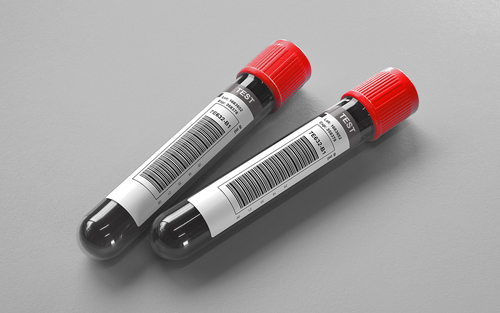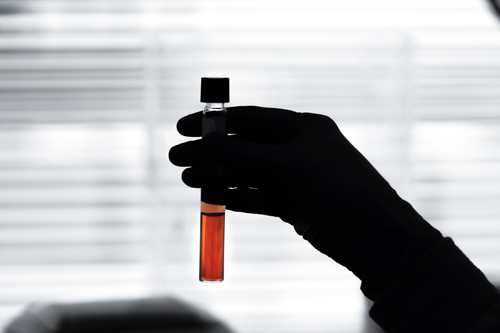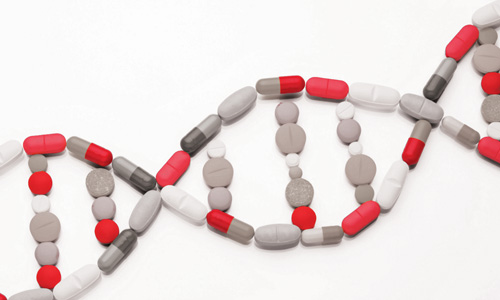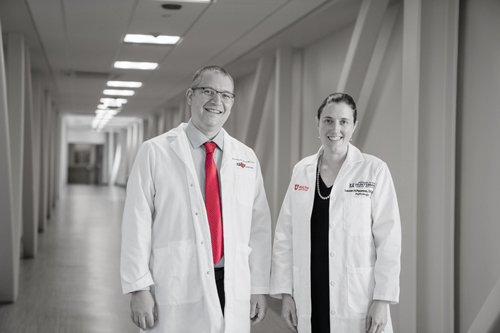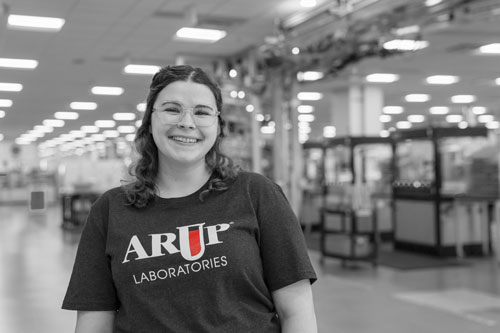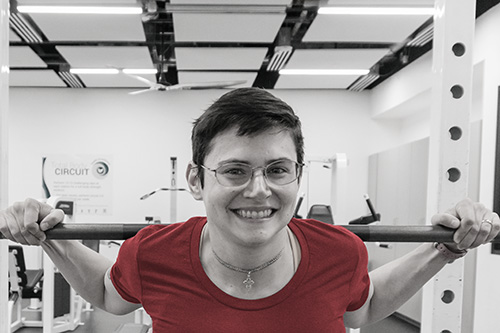
Sherin Shaaban, MD, PhD, MSci, FACMG, ARUP medical director of Pharmacogenomics and Molecular Genetics, is the expert overseeing two ARUP tests that detect nine well-studied variants of DPYD.
Understanding DPYD Genotyping
What is DPYD genotyping?
DPYD genotyping is a genetic test that identifies variants in the DPYD gene, which encodes the enzyme dihydropyrimidine dehydrogenase (DPD). This enzyme is essential for breaking down fluoropyrimidine chemotherapy drugs, such as 5-fluorouracil (5-FU) and capecitabine (Xeloda). Patients with certain DPYD variants may be at risk for severe or even fatal toxicity from these drugs.
Who should consider the test?
Patients who are about to begin treatment with fluoropyrimidine-based chemotherapy should consider DPYD genotyping. This includes individuals diagnosed with colorectal, anal, rectal, and small bowel cancers. Testing can help guide safer and more effective dosing strategies.
How do I learn more?
Talk to your oncologist about DPYD genotyping and whether it is appropriate for your treatment plan. For more information about the test, read this ARUP Test Fact Sheet, or visit this topic on ARUP Consult.
When Emily Alimonti first learned of her cholangiocarcinoma diagnosis in December 2024, the Albany, New York, biotech saleswoman went to work researching all aspects of her disease and its treatment.
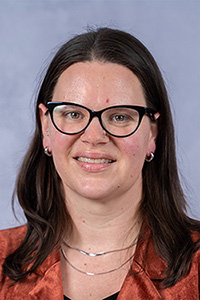
She is fortunate she did, because her proactive approach turned up information about a rare genetic condition that makes some patients with cancer poor metabolizers of common chemotherapy drugs, making the drugs potentially fatal to these patients in high doses.
Known as dihydropyrimidine dehydrogenase (DPD) deficiency, the condition inhibits the body’s production of the enzyme that is key to breaking down fluoropyrimidine drugs used to fight cancer, such as 5-fluorouracil (5-FU) and capecitabine (Xeloda).
Alimonti insisted that she be tested for variants of the DPYD gene, which encodes DPD, despite the reluctance of both her Albany oncologist and a New York City oncologist she consulted for a second opinion. The genotyping panel that her hometown oncologist eventually ordered showed that she is among the 8% of the U.S. general population that the Clinical Pharmacogenetics Implementation Consortium (CPIC) estimates have at least one copy of a variant associated with DPD deficiency.
“The oncologists kept saying, ‘You know, it’s very rare that people have this deficiency, so rare that we don’t test for it here,’” Alimonti said. “If I had listened to them, the chemo could have killed me.”
Alimonti and other advocates for DPYD genotyping are encouraged by a long-awaited change to the National Comprehensive Cancer Network’s (NCCN’s) colon, anal, rectal, and small bowel cancer treatment guidelines. In a March 31, 2025, guideline that was updated in June, the NCCN acknowledged that DPYD variants significantly increase the risk of severe or fatal fluoropyrimidine toxicity. It now recommends that “testing for DPYD genetic variants should be discussed with patients prior to fluoropyrimidine therapy and should be considered in the context of the patient’s circumstances.”
Notably, the updated guidelines repeat a safety alert that the FDA issued in January 2025 in which it recommended that providers be aware of the risks of DPD deficiency, inform patients about the potential for serious toxicities associated with the condition, and discuss testing options. The agency previously had updated the labels of 5-FU and Xeloda with more information about the risk to poor metabolizers of the drugs.

While the NCCN update stops short of recommending testing, Ryan Nelson, PharmD, ARUP medical director of Precision Medicine, sees it as a critical shift in clinical pharmacogenetics. A longtime advocate along with other pharmacists for broad DPYD genotyping, he called the change “a case study in how scientific diplomacy and evidence-based advocacy can shift positions.”
“The body of evidence is clear, and it continues to grow,” Nelson said, adding that the change places more responsibility on oncologists to discuss DPYD genotyping and will urge more insurers to pay for the relatively inexpensive test, which has already been broadly adopted in Europe.
“Going through chemotherapy is a brutal process, and getting too toxic of a dose is yet another assault that adds to the fear, vulnerability, and misery that is cancer treatment,” Nelson said. “We have a test that can mitigate the risk, and while the NCCN’s updated recommendation is great news, I’d like to see DPYD genotyping become the standard of care before prescribing cancer treatment.”
Karen Merritt, a cofounder of Advocates for Universal DPD/DPYD Testing (AUDT), called the updated NCCN guidelines a “huge step,” but the Seattle teacher said she, too, is hopeful the NCCN will eventually take a stronger stance.
While she said more cancer centers are recommending DPYD genotyping to patients (she counts about a dozen major centers in the U.S. so far), progress has been slow.
“We can’t continue to try to change the standard of care one institution at a time,” said Merritt, whose mother died in 2014 from the accumulation of toxic levels of 5-FU during chemotherapy that led to the failure of multiple organs. “We want this testing to be universal in the United States.”
Despite its known clinical utility, DPYD genotyping has historically faced resistance from some oncologists and guideline-setting bodies such as the NCCN because oncologists feel an understandable urgency to start chemotherapy, particularly for those with advanced disease, said Sherin Shaaban, MD, PhD, MSci, FACMG, ARUP medical director of Pharmacogenomics and Molecular Genetics. Oncologists have been reluctant to wait for genetic test results that may change the course of treatment for only a few patients.
Oncologists historically have also wanted to avoid the possibility of reduced efficacy of the drugs if they lower doses for patients identified as having a DPYD variant, Shaaban said.
Another layer of complexity involves the limitations of the testing itself. Most current DPYD tests, including those offered by ARUP, use targeted genotyping, which only screens for known, well-studied variants, Shaaban said. While these tests are valuable, they cannot detect rare or novel mutations that might also impact drug metabolism.
She said that negative results only mean that patients do not carry the specific variants tested, not that they are entirely free of risk. This limitation has contributed to the cautious stance of guideline bodies, which avoid basing clinical mandates on incomplete data.
Despite these challenges, Shaaban said she, like Nelson, sees the updated NCCN guideline as a turning point, particularly when it is viewed in the context of the FDA safety alert and actions by other guideline-creating bodies, including CPIC and the Association for Molecular Pathology (AMP).
CPIC provides reliable and up-to-date dosage recommendations for patients with DPYD variants identified by testing, while AMP, in collaboration with CPIC and other organizations, provides recommendations that help clinical laboratories such as ARUP develop consistent and clinically meaningful DPYD genotyping panels that test for relevant variants.
“The convergence of multiple authoritative guidelines has created a more solid foundation for recommending DPYD testing,” said Shaaban, noting that ARUP’s test volumes are growing.
She added that ARUP has expanded its DPYD panels to include variants to align with AMP’s recommendations. Two ARUP tests, Dihydropyrimidine Dehydrogenase (DPYD) and Dihydropyrimidine Dehydrogenase (DPYD) and UPD Glucuronosyltransferase 1A1 (UGT1A1) Genotyping, now test for nine rather than three variants. The change improves detection of relevant variants in more patients, including African Americans.
Shabaan said the evolution in testing capability, combined with growing advocacy from clinicians, pharmacists, and patient groups, is helping to shift the conversation from, “Should we test?” to, “How can we implement testing more effectively?”
“There is significant value in waiting for the genotyping results,” Nelson said, especially when test turnaround times are improving (ARUP’s published turnaround time is five to 10 days) and the consequences of not testing can be fatal. He and Shaaban hope that with continued advocacy and education, preemptive DPYD testing will become a routine part of safe and effective chemotherapy planning.
Alimonti shares this hope.
The knowledge that she has a variant that makes her vulnerable to potentially fatal toxicity from capecitabine led her oncologist to prescribe lower doses of the drug that are working for her.
As she continues to work with her treatment team to manage her cancer, she’s also working with AUDT to help educate clinicians and patients and get the word out about the importance of DPYD testing any way she can.
While she hopes and waits for more action from guideline-creating bodies, Alimonti wants other patients who have been diagnosed with cancer to adopt her approach.
“You have to advocate for yourself,” she said. “Yes, oncologists are the medical professionals, but they’re not you.”
Lisa Carricaburu, lisa.carricaburu@aruplab.com

